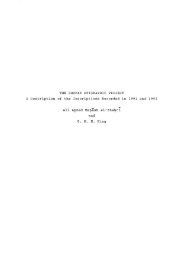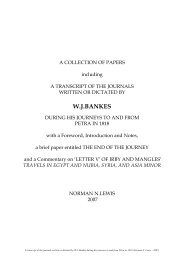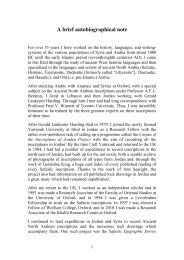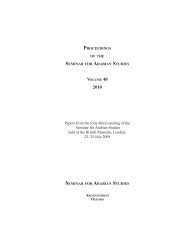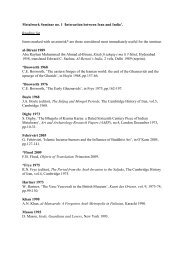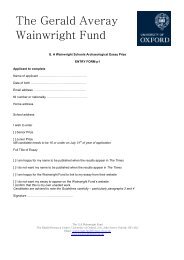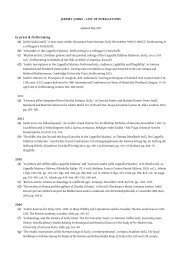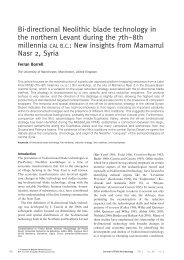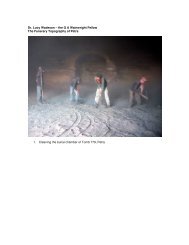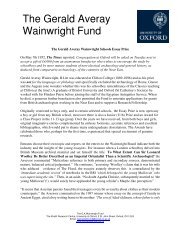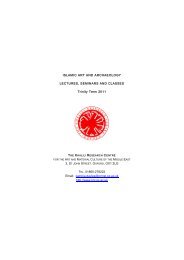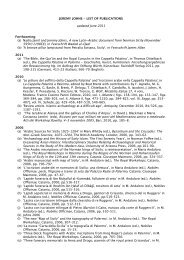W. J. Bankes and the Identification of the Nabataean Script - Khalili ...
W. J. Bankes and the Identification of the Nabataean Script - Khalili ...
W. J. Bankes and the Identification of the Nabataean Script - Khalili ...
Create successful ePaper yourself
Turn your PDF publications into a flip-book with our unique Google optimized e-Paper software.
48 N.N. LEWIS <strong>and</strong> M.C.A. MACDONALD<br />
Syria 80 (2003)<br />
WILLIAM JOHN BANKES<br />
W. J. <strong>Bankes</strong> (1786-1855) was one <strong>of</strong> a number <strong>of</strong> gifted <strong>and</strong> scholarly Europeans who explored <strong>the</strong> Near East<br />
in <strong>the</strong> early nineteenth century (Fig. 1). He spent most <strong>of</strong> <strong>the</strong> years 1815-1819 in <strong>the</strong> visitine region, g Sinai, Egypt,<br />
Nubia, > (i.e. <strong>the</strong> area covered by modem Lebanon, Syria, Jordan, Palestine <strong>and</strong> Israel), Greece,<br />
Constantinople, <strong>the</strong> sou<strong>the</strong>rn <strong>and</strong> western coastl<strong>and</strong>s <strong>of</strong> Asia Minor, <strong>and</strong> Cyprus. As he travelled, he left , as two <strong>of</strong> his companions put it, 48 <strong>and</strong> wherever he went he copied inscriptions, made sketches,<br />
detailed drawings <strong>and</strong> plans <strong>of</strong> buildings, <strong>and</strong> painted occasional water-colours. Unfortunately, he seems to have<br />
kept journals only infrequently <strong>and</strong> <strong>the</strong> o<strong>the</strong>r notes he left vary greatly in quality.<br />
<strong>Bankes</strong> was a man <strong>of</strong> considerable<br />
exploring.49 He was also an excellent<br />
draughtsman <strong>and</strong> had an unusually acute <strong>and</strong><br />
accurate eye in recording inscriptions, even<br />
when he could not read <strong>the</strong> script. However, he<br />
was not content simply to copy inscriptions<br />
<strong>and</strong> to make drawings or paint water-colours.<br />
Those <strong>of</strong> his letters, journals <strong>and</strong> notes which<br />
have survived show that he gave much thought<br />
to <strong>the</strong> questions suggested by what he sawwho<br />
constructed <strong>the</strong> buildings, who carved <strong>the</strong><br />
inscriptions <strong>and</strong> what did <strong>the</strong>y mean? He was<br />
...· _ has7~ \~ <strong>the</strong> ~ ~ _e ~ ~.L thus able to take one <strong>of</strong> <strong>the</strong> first steps towards<br />
i"~ ~~ ~ ~~~..0' &.<br />
wasr~~ by:~~ farwhile<br />
t<strong>the</strong> decipherment <strong>of</strong> Egyptian hieroglyphics, 50<br />
<strong>the</strong> progress <strong>of</strong> his speculations on <strong>the</strong><br />
49.: Thus ....or istanc, authors <strong>of</strong> <strong>the</strong> inscriptions in an unknown<br />
script which he found in Sinai, possibly in<br />
.... %_ ":~~~ Nubia, ,' in <strong>the</strong> Hawrin <strong>and</strong>, at last, in Petra,<br />
are <strong>the</strong> deductions <strong>of</strong> an intelligent man using<br />
what material was at his disposal <strong>and</strong> arriving<br />
Fig. 1.- Portrait sketch <strong>of</strong> W.J <strong>Bankes</strong> ( 1786-1855) at <strong>the</strong> correct conclusion.<br />
by George Hayter, c. 1833<br />
(courtesy <strong>of</strong> <strong>the</strong> National Trust)<br />
<strong>Bankes</strong>' travelling companions <strong>and</strong> many<br />
dontemporary scholars recognized his<br />
abilities, praised his achievements <strong>and</strong><br />
confidently expected him to publish an account <strong>of</strong> his work. Irby <strong>and</strong> Mangles, who travelled with him to Petra,<br />
wrote that <strong>Bankes</strong><br />
... has <strong>the</strong> merit <strong>of</strong> being <strong>the</strong> first person travelling as a European, who ever thought <strong>of</strong> extending his researches in<br />
that direction [i.e. to Petra]; <strong>and</strong> from his pr<strong>of</strong>ound knowledge <strong>of</strong> ancient history, as well as his skill in drawing, he<br />
was by far <strong>the</strong> best calculated to go on such an expedition 52<br />
48. IRBY & MANGLES 1823: 293.<br />
49. Thus, for instance, Irby <strong>and</strong> Mangles record that he visited <strong>the</strong> library <strong>of</strong> <strong>the</strong> Latin convent <strong>of</strong> Terra Sancta in Jerusalem to consult<br />
an edition <strong>of</strong> Vitruvius in order to explain features <strong>of</strong> <strong>the</strong> Roman <strong>the</strong>atre at Beth-Shean, (IRBY & MANGLES 1823: 302).<br />
50. See below.<br />
51. See below, under <strong>Bankes</strong>' journey to Petra, <strong>and</strong> note 232.<br />
52. IRBY & MANGLES 1823: 336.



